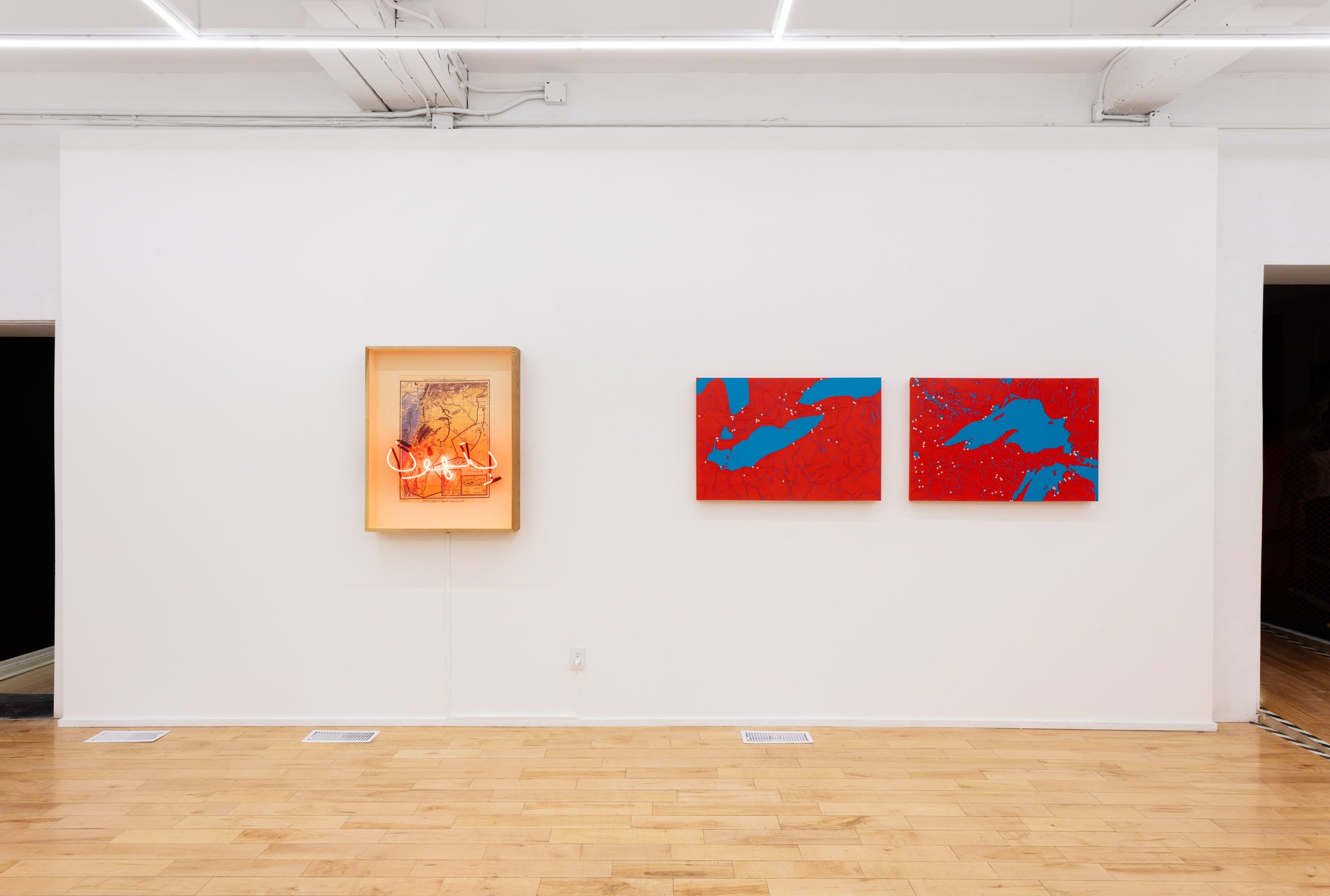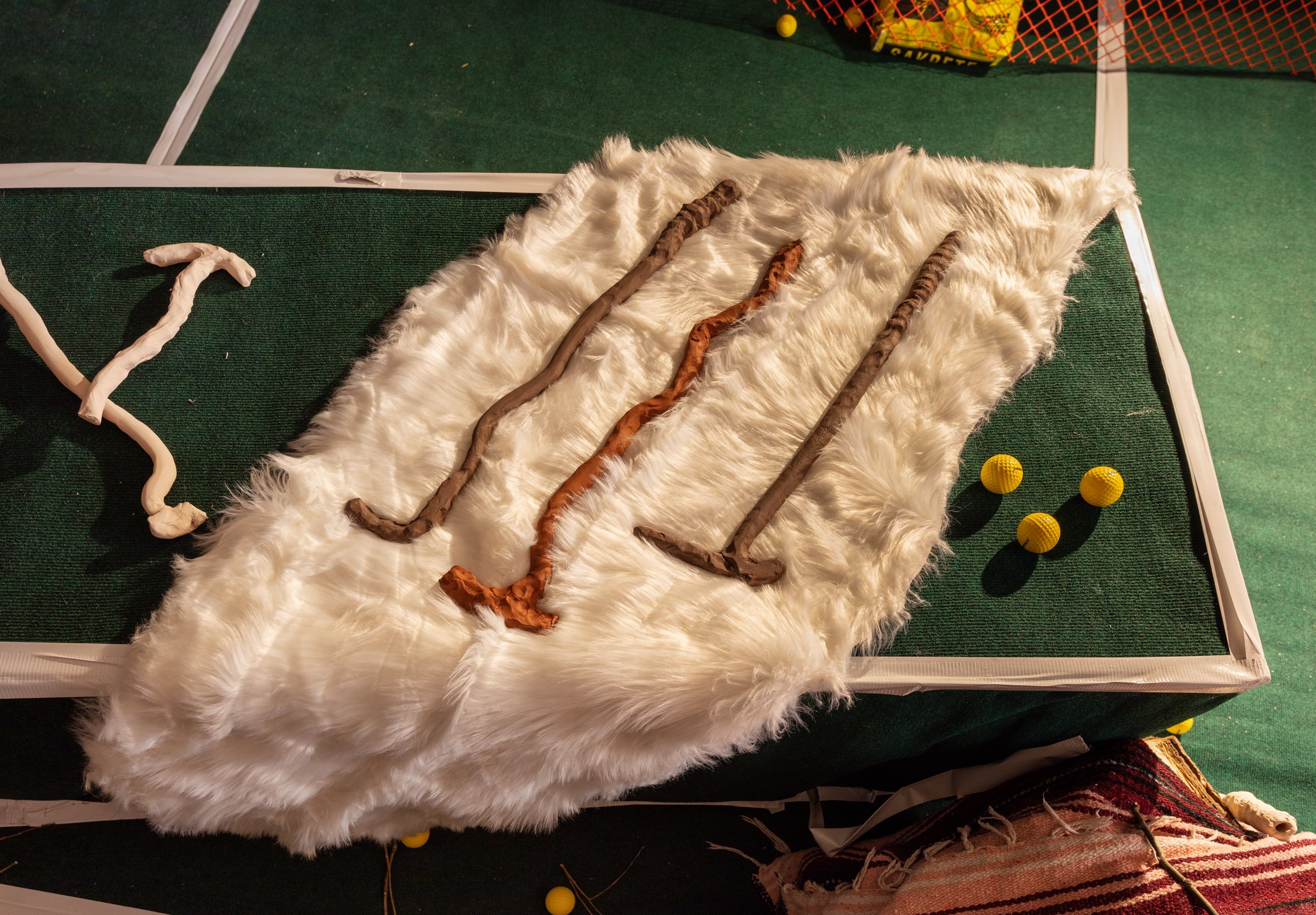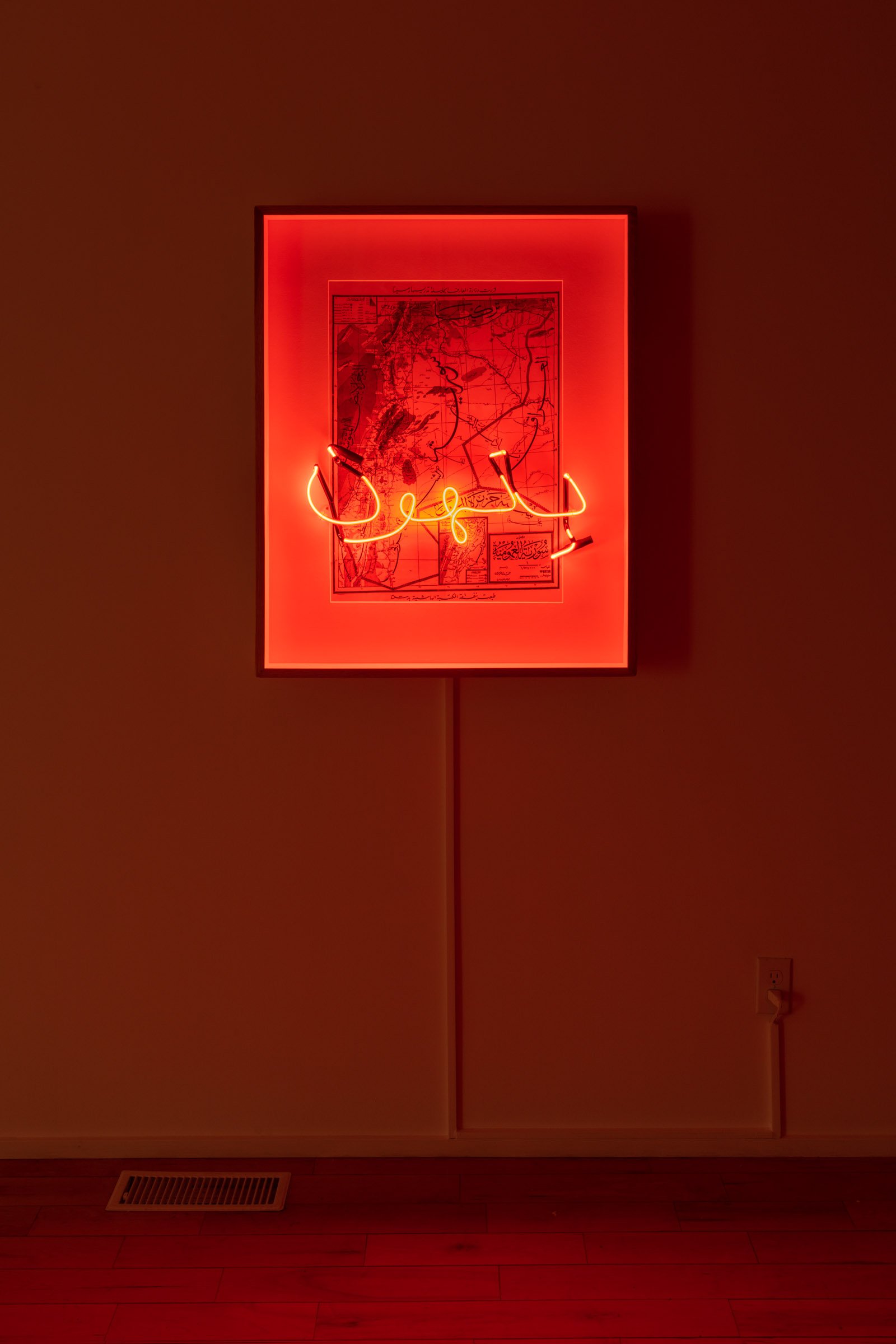
this is not an atlas
Jude Abu Zaineh, Bonnie Devine, Bruno Canadien,
Maria Hupfield, Teo Monsalve, Su Yu Hsin, Joseph Tisiga
Curated by Noor Alé
January 9 - March 26, 2022
“The map is open and connectable in all of its dimensions; it is detachable, reversible, susceptible to constant modification. It can be torn, reversed, adapted to any kind of mounting, reworked by an individual, group, or social formation. It can be drawn on a wall, conceived of as a work of art, constructed as a political action or as a meditation.”
—Gilles Deleuze and Félix Guattari, A Thousand Plateaus: Capitalism and Schizophrenia (1980)
this is not an atlas examines notions of mapping, mythologies, and belonging in the works of artists Jude Abu Zaineh, Bruno Canadien, Bonnie Devine, Maria Hupfield, Teo Monsalve, Su Yu Hsin, and Joseph Tisiga. The gathered works—among them paintings, prints, video and site-specific installations—make visible the histories and realities of sovereignty and resilience by remapping, reorienting, and reclaiming cartography as a decolonial practice.
Cartography charted the expansion of European empires into the Americas, Africa, and Asia, fuelling the forced expropriation of Indigenous lands. Authored by surveyors, maps are neither neutral nor objective; they serve as ideological tools articulating power hierarchies, economic motivations, and nationalistic agendas. The exhibition’s title is borrowed from a global collection of counter-cartographic writings by artists, environmentalists, and scholars who create maps to engender political activism.
Image credit: Teo Monsalve, Pasto Astronomer, 2021. Oil and watercolour on inkjet print, 11.8 x 15.7 inches.
Image credits: (left) Su Yu Hsin, water sleep II Akaike river under Xizang Road, 2019. Single-channel video, colour, sound, 10:24 minutes. Commissioned by Flaneur magazine. (right) Maria Hupfield, Eagle Dance: The Residual Effect with Red Thunderer, 2009. Ink on paper, 40 x 26 in. Collection of Carlos Yep, Toronto.
Maria Hupfield
Eagle Dance: The Residual Effect with Red Thunderer, 2009.
Ink on paper, 40 x 26 inches.Collection of Carlos Yep, Toronto.
Muhheakantuck—a Lenape word meaning “the river that flows both ways”—is the ancestral name for the estuary that now commemorates Henry Hudson. Anishinaabe artist Maria Hupfield investigated maps and abstractions of history to unravel preconceived notions of this estuary. Her drawing Eagle Dance: The Residual Effect with Red Thunderer was inspired by her research of Muhheakantuck, which revealed similarities between the dual currents of the river with Indigenous notions of governance. In Eagle Dance, Hupfield employs layers of Anishinaabe origin imagery that double as symbols of Western governments to invite open interpretations. The eagle represents a revered Anishinaabe sky world figure while also recalling the emblem of the United States. A prominent red line extends across the work, an assertion of the artist’s hand to remind us of the symbolic nature of the drawing.
Transdisciplinary artist Maria Hupfield activates her work in live performances. She is interested in the formation of shared moments that open spaces for possibility and new narratives. In her work, these moments of connection are recalled and grounded by coded and re-coded hand-sewn industrial felt creations and other material mash-ups worn on the body. An urban off-reservation member of the Anishinaabek People, she belongs to the Wasauksing First Nation. She has exhibited her work at the National Gallery of Canada, Ottawa; Montreal Museum of Contemporary Art; and The Power Plant Contemporary Art Gallery, Toronto. Together with her husband Jason Lujan she co-owns Native Art Department International. She is the Canadian Research Chair in Transdisciplinary Indigenous Arts at the University of Toronto Mississauga. Hupfield lives and works in Toronto.
Jude Abu Zaineh
بِتهون | Bithoon (with map of Palestine), 2021
Neon in glass tubes, electrodes, transformer, digital print of map. 36 x 29 x 5 inches.
In Arabic, بِتهون (pronounced: bit-hoon) is a common single-word saying which is applicable to many situations. This meaningful word roughly translates to: this too shall pass; everything will be alright; or, have patience. Overlaid on a map of the Levantines, the warm glow of the neon evokes notions of resilience, equanimity, and hope, in a longstanding act of perseverance and self-determination for those who endure exile, displacement, and dispossession from their homelands in this broad region.
Written in Arabic, the work addresses audiences from the Levantines whose experiences are similarly shaped by colonial occupations and military interventions in this territory, particularly Syria, Lebanon, Jordan, Iraq, Egypt, and Palestine. For Jude Abu Zaineh—who is a Palestinian-Canadian artist—this work is a personal call to action to pause, reflect, and reimagine her constant search for home and belonging.
Jude Abu Zaineh is a Palestinian-Canadian interdisciplinary artist and cultural worker. Her practice employs art, food, and technology to investigate meanings of culture, displacement, diaspora, and belonging. Abu Zaineh’s work examines ideals of home and community and recalls visual tropes rooted in her childhood and upbringing in the Middle East. She has presented her work at the Art Gallery of Windsor; Museu de Arte, Arquitetura e Tecnologia, Lisbon; and Centro de Cultura Digital, Mexico City. Currently, Abu Zaineh is pursuing her PhD in Electronic Arts at Rensselaer Polytechnic Institute, Troy, as a SSHRC Doctoral Fellow, and holds an MFA from the University of Windsor. In 2020, she was awarded the William and Meredith Saunderson Prize for Emerging Artists. Abu Zaineh lives and works in upstate New York and Windsor, Ontario.
Bruno Canadien
Anishinaabeewi-gichigami and Waabishkiigoo-gichigami, 2021.
Acrylic, graphite on canvas, 24 x 36 x 1.5 inches
Dene artist Bruno Canadien’s paintings Anishinaabeewi-gichigami (Anishinaabe’s Sea) and Waabishkiigoo-gichigami (Neutral’s Sea) form part of his Constellation series, an ongoing body of work that asserts the presence of First Nations and their diasporas by mapping their contemporary populations across Turtle Island—the continent of North America—and the settler states of Canada and the United States. The artist’s mapping reimagines a decolonized landscape and calls into question emergent power dynamics. In these two paintings, Canadien foregrounds two bodies of water from the Nayaano-nibiimaang Gichigamiin (Five Freshwater Seas)—known as the Great Lakes—to render visible the relations of First Nations with the land and bodies of water within their ancestral territories.
Resisting the map’s colonial lines of control, Canadien expunges coordinate systems, measurements, and scales from his rendering of the Nayaano-nibiimaang Gichigamiin region. As a sovereignty-seeking artist, Canadien disavows the Cartesian map that is deployed to legitimize nationalistic agendas and military pursuits that enable the expropriation of Indigenous lands throughout Turtle Island, and beyond. The titles of these works are in Anishinaabemowin and were drawn from the Decolonial Atlas, an online collection of counter-cartographic maps that envision a world liberated from colonialism, extractivism, and capitalism.
Bruno Canadien is a member of the Deh Gah Got’ı́é Dene First Nation, a Deh Cho Region member of the Dene Nation. Canadien’s art practice is primarily focused on addressing issues surrounding the intersection of First Nations/Tribal sovereignty, resource exploitation and environmental concerns. Using collage, adornment, painting and drawing, Canadien presents evidence of contemporary Indigenous presence and resistance throughout his work. His work has evoked concern Indigenous communities in so-called western Canada and the U.S. have for their territories in the face of aggressive oil and gas exploration and extraction. As a member of a northern First Nation and a resident of the province of Alberta, this issue carries personal resonance for Canadien, especially in regards to the effects of the Athabasca Tarsands development, which is located upstream from his home community of Fort Providence, within the MacKenzie-Peace watershed. Canadien’s work can be found in private and public collections, including the Alberta Foundation for the Arts, Edmonton; Glenbow Museum, Calgary; Nickle Galleries, Calgary; and Indigenous Art Centre, Ottawa. Bruno currently resides in the Moh’kinsstis (Calgary) area, gratefully grounding himself in the landscapes and traditional territories of the Siksikaitsitapi, Tsuut’ina and Îethka Nakoda Wîcastabi nations.
Teo Monsalve
Cuentos del Cielo (The Tales of the Sky): An exercise for visualizing the Pluriverse, 2021.
Mixed media on inkjet prints and canvas, dimensions variable.
Los Cuentos del Cielo by Ecuadorian artist Teo Monsalve is a mixed media work on paper that appropriates German astronomer Johan Bayer’s Uranometria (1603), a collection of engraved illustrations that rendered constellations as classical mythological figures that charted 51 stars across northern and southern hemispheres. In comparison to Uranometria—which translates to measuring the heavens—Monsalve’s Cuentos del Cielo foregoes Western mathematical projections of the celestial spheres, and instead chronicles a reworlding of the cosmos. In a decolonial act, Monsalve reconfigures these constellations by drawing imagery from various disciplines such as natural sciences, astronomy, and world histories to create a global imaginary that embraces all worldviews within it.
Teo Monsalve is an Ecuadorian artist whose multidisciplinary practice explores themes relating to the natural world of the Andes and the Amazon region of Ecuador. The predominant concerns in his practice are engaged with ideas of interculturality, interspecies relationships, geographical contexts, and metamorphosis, both mythological and botanical. Weaving multiple narratives, drawn from his home country of Ecuador and his experience of living in Canada, Monsalve brings to his practice a range of influences reflecting his mestizo relationship with the Americas and the larger global sphere. His work was exhibited at No Lugar, Quito; Emily Carr University of Art + Design, Vancouver; and Khora Gallery, Quito. Monsalve works and lives in Quito.
Su Yu Hsin
water sleep II Akaike river under Xizang Road, 2019.
Single channel video, colour, sound, 10:24 minutes. Commissioned by Flaneur magazine.
Taiwanese artist Su Yu Hsin’s water sleep II Akaike river under Xizang Road is a film that challenges the political forces that inform mapmaking and questions the validity of maps, their relationship to reality and representation. When a map is authored by a colonizing nation there are purposeful omissions, such as the erasure of ancestral names, and at times geographic sites, which impact the way we interpret maps. In this film, the artist guides us in search for the lost Akaike river in historical maps, including Taipei/Taihoku City Planning Map with Bird’s-eye View (1935) and Taihoku Aerial Map, American Army 14th Air Force (1944) which represent the colonial history of Taiwan. Through the search for the river—taking place on a motorbike in the city above the hidden river—the artist provides another decolonial reading of maps and turns the focus towards evidence of objective portraits of the landscape.
Su Yu Hsin is a Taiwanese artist and filmmaker based in Berlin. She approaches ecology from the point of view of its close relationship with technology. In her film and video installations, her artistic research reflects on technology, ecology, and the critical infrastructure in which the human and non-human converge. Her analytical and poetic storytelling focuses on map-making, operational photography, and the technical production of geographical knowledge. Su has participated in exhibitions at the Centre Pompidou-Metz, Museum of Contemporary Art Busan; Taipei Biennial; ZKM Karlsruhe; Kyoto Art Center; UCCA Center for Contemporary Art, Beijing; Haus der Kulturen der Welt, Berlin; and Junín Contemporary Art Museum. She was a finalist in the 8th Huayu Youth Award in 2020, and LOOP Barcelona Discover in 2018.
Bonnie Devine
Writing Home 2, What the Moose Dreamed, 2022.
Acrylic paint and pencil.
Writing Home 2, What the Moose Dreamed is a site-specific mural by Anishinaabe artist Bonnie Devine that depicts a moose who is narrating and dreaming the Great Lakes region into creation. Painted in an inky blue that centres the imagery of water, this mural is a personal letter written by the artist to these lakes and the surrounding lands, reflecting spatial relationships that are ancestral, intimate, and poetic. Writing Home 2, What the Moose Dreamed also speaks to the discursive and textual nature of maps, as cartography is the practice of writing the land. The intuitive mark making process of the work—gestural markers, splatters, and the grid lines—recalls the act of writing letters with ink. This work reimagines and expands cartography as a practice that is rooted in spiritual relationships.
Bonnie Devine is an installation artist, video maker, curator, and writer. A member of the Anishinaabek of Genaabaajing, (Serpent River First Nation) on the north shore of Lake Huron, Devine’s work emerges from the storytelling and image-making traditions that are central to Anishinaabe culture. Using cross-disciplinary approaches and iterations of written, visual, and performative practice Devine explores issues of land, environment, treaty, history, and narrative. Though formally educated in fine art at OCAD University and York University in Toronto, Devine’s most enduring learning came from her grandparents, who were trappers on the Canadian Shield in northern Ontario. She has exhibited her work at the Art Gallery of Ontario, Toronto; McMichael Canadian Art Collection, Kleinburg; and National Museum of the American Indian, Washington, D.C. In 2021, she received the Governor General’s Award in Visual and Media Arts. Devine is an Associate Professor Emerita and the Founding Chair of the Indigenous Visual Culture program at OCAD University. Devine lives and works in Toronto.
Joseph Tisiga
Ring of Fire, 2022
Mixed media installation with sound.
Kaska Dena artist Joseph Tisiga’s Ring of Fire is a multimedia installation that critiques the interrelationships between colonialism, extractivism, environmental degradation. The work borrows its title from the name given to a massive mineral development project in the James Bay Lowlands of Northern Ontario. Richard Nemis—the founder of Noront Resources which oversees this mineral extraction project—named the mineral site after a song by American singer Johnny Cash. Responding to the lack of consultation and care towards the environment, the Attawapiskat, Fort Albany, Neskantaga, Kashechewan and Eabametoong First Nations chiefs jointly wrote a letter to Steven Guilbeault, federal Minister of Environment and Climate Change that noted: “These are the world’s lungs, and rampant mining development could not only destroy this globally critical carbon sink but release its huge store of carbon and escalate climate change further into catastrophe.”
This installation features an unusual mini-golf course that references the Oka Crisis—a seventy-eight day standoff in the summer of 1990—in which Mohawk land defenders from the Kanesatake Nation demonstrated against the Canadian Government’s encroachment into a sacred burial site in Oka, Québec. This work reflects on First Nation and colonial tensions around land, the obscene impetus for the Oka encroachment was prompted by the expansion of a golf course on Kanesatake lands. Ring of Fire brings to light the divisiveness around recreational uses of land by colonial interests while ignoring the historical displacement of Indigenous people.
Joseph Tisiga is a member of the Kaska Dena Nation whose multidisciplinary practice includes painting, drawing, installation, and performance. His work reflects upon notions of identity and what contributes to this construct—community, nationality, family, history, location, real and imagined memories—questions that have become all the more relevant in the current climate. He has exhibited his work at the National Gallery of Canada, Ottawa; Museum of Contemporary Native Arts, Santa Fe; and Massachusetts Museum of Contemporary Art. His work is held in the collections of the Montreal Museum of Fine Arts; Audain Art Museum, Whistler; and Kitchener-Waterloo Art Gallery. In 2021, he received the Yukon Art Prize, and the Sobey Art Award in 2020. Tisiga lives and works in Montreal.
Curator Biography:
Noor Alé is a curator, art historian, and writer. She is the Associate Curator at The Power Plant Contemporary Art Gallery, Toronto. Her curatorial practice examines the intersections of contemporary art with geopolitics, decolonization, and social justice in the Global South. She has contributed to curatorial research, exhibition management, and public programmes at the National Gallery of Canada, Ottawa; Solomon R. Guggenheim Museum, New York; and Art Dubai. Alé holds an MA in Art History from The Courtauld Institute of Art, and a BA in Art History from the University of Guelph. Alongside Claudia Mattos she co-founded AXIS, an independent curatorial laboratory dedicated to exhibiting socially-engaged contemporary art. She was awarded curatorial residencies at the Banff Centre for Arts and Creativity, and the Shanghai Curators Lab.











Documentation by Laura Findlay.










